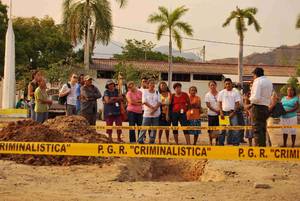
Mexico, D.F.- June 12, 2013. “Service City” retains the look of the old barracks of the 27th military zone in the municipality of Atoyac de Álvarez, in the Costa Grande region of Guerrero. According to testimony collected, this was the last place Rosendo Radilla Pacheco was seen after his detention at a military check point and disappearance in august of 1974. From May 20-June 1, specialized personnel from the Attorney General's Office, the National Institute of Anthropology and History and two expert forensic anthropologists explored three areas to search for the remains of the social leader from Guerrero. These excavations were carried out in compliance with the sentence emitted in 2009 by the Inter-American Court on Human Righs in the case of Radilla vs. Mexico.
During the first days of work, a period which tends to be marked by nervousness and hope, Tita Radilla, daughter of Rosendo Radilla and vice-president of the Association of Families of the Detained-Disappeared and Victims of Human Rights Abuses in México (AFADEM), along with her siblings and other family members of those disappeared during the Dirty War were accompanied by Peace Brigades International (PBI) and the Mexican Commission on Defense and Promotion of Human Rights (CMDPDH). Despite the anxiousness that the excavations imply, Tita manifested that “we hope to find something”.
Work began each day at 8:00am and continued until 6:00pm, with breaks for lunch and to mitigate the hot and humid climate of the region. Each morning, Tita Radilla and other family members arrived early to the ex-military base and divided themselves in groups in order to observe the work of the specialists in the marked zones. These areas were previously identified, in March of this year, with a georader, which detected anomalies in the subsoil in three different locations. “All of those alterations could be remains. So we are confirming what appeared on the georader”, explained Franco Mora, forensic anthropologist from the Peruvian Team of Forensic Anthropologists (EPAF), a non governmental, non-profit organization which searches for people disappeared during the armed conflict in Peru and who have come to Mexico to help the AFADEM.
One of three zones was dismissed from the beginning. “We have two areas of work, the first (…), according to what has been reported, was the zone where detained people were tortured. They are opening several trenches which are more than 8 meters wide and 2 long. In the other zone, which is where the heliport is located, they are also opening trenches, lifting the asphalt in order to see what is underneath”, the expert said. At the end of the day, both the government and independent specialists explained to family members what work has been done and the results obtained. The search process is wearying, especially after almost four decades of struggle. Due to the strong emotions they experience, family members receive psycho-social support.
During the excavations, the third series since the Inter-american Court sentence, Tita Radilla and the AFADEM family members agreed to paint a banner with the title “Truth, Justice and Reparations” for the International Week of the Detained-Disappeared. Streets in Atoyac were renamed to give homage to families of the disappeared. Despite the effort and the waiting, during the 13 days of work no evidence was found as to the whereabouts of Rosendo Radillo or the other approximately 600 people that were disappeared, the majority during the 60s and 70s.
Today, members of the AFADEM continue to demand effective investigations so that the excavations will continue adequately and achieve results. According to Tita, this hasn't been the case; “several soldiers gave testimony, but they haven't contributed anything new”, she affirms. The family members demand that the Mexican State bring the perpetrators of human rights violations committed during the Dirty War to justice and comprehensive compliance with the Inter-American Court sentence, which requires investigation of the events that lead to the disappearance of Rosendo Radilla. According to Tita “several things are still needed” in order to comply with the Sentence and she will continue until the end.
More information
CMDPDH: Diary of the excavations (Spanish)
